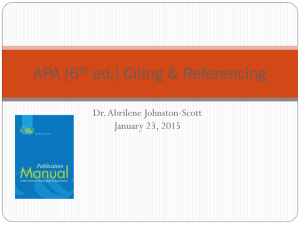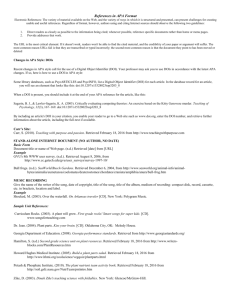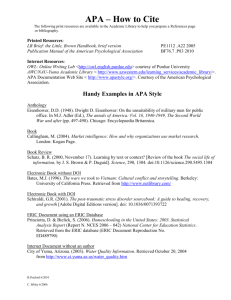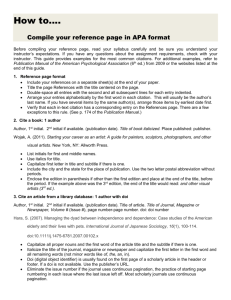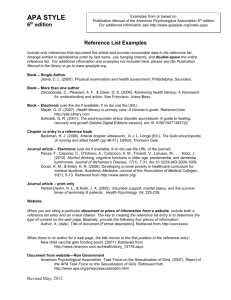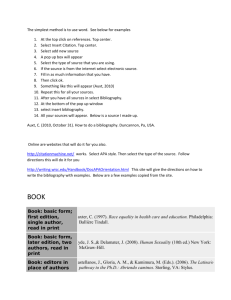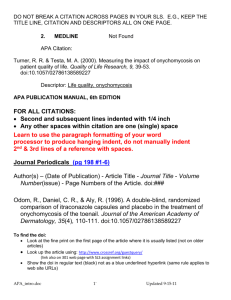microbes3C21
advertisement
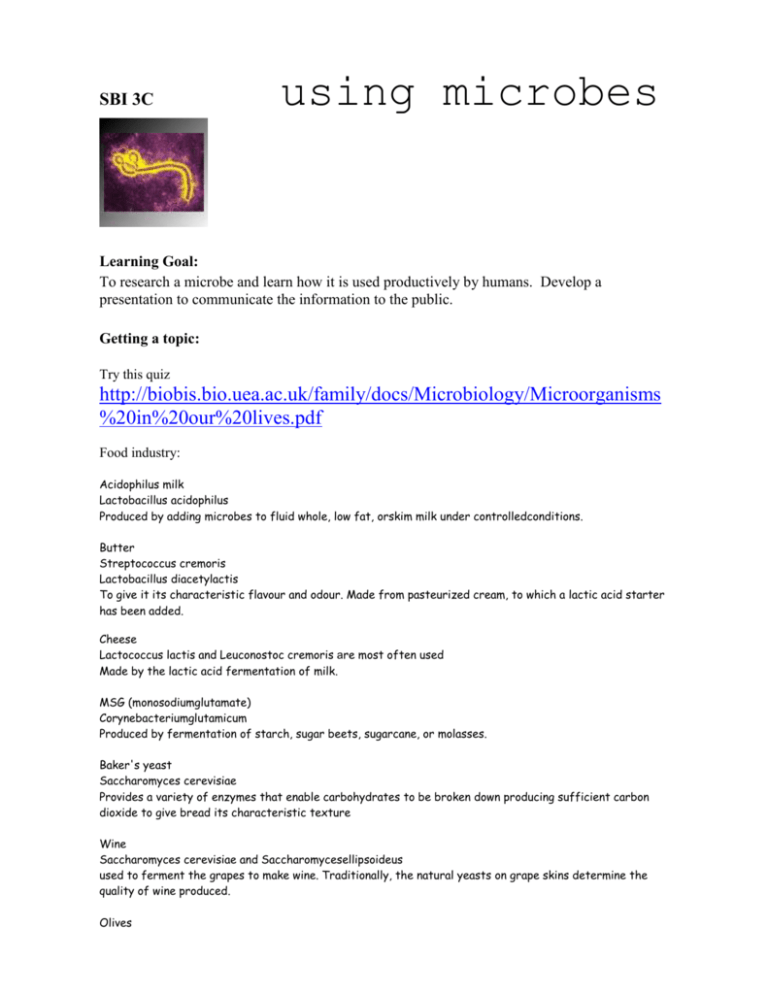
SBI 3C using microbes Learning Goal: To research a microbe and learn how it is used productively by humans. Develop a presentation to communicate the information to the public. Getting a topic: Try this quiz http://biobis.bio.uea.ac.uk/family/docs/Microbiology/Microorganisms %20in%20our%20lives.pdf Food industry: Acidophilus milk Lactobacillus acidophilus Produced by adding microbes to fluid whole, low fat, orskim milk under controlledconditions. Butter Streptococcus cremoris Lactobacillus diacetylactis To give it its characteristic flavour and odour. Made from pasteurized cream, to which a lactic acid starter has been added. Cheese Lactococcus lactis and Leuconostoc cremoris are most often used Made by the lactic acid fermentation of milk. MSG (monosodiumglutamate) Corynebacteriumglutamicum Produced by fermentation of starch, sugar beets, sugarcane, or molasses. Baker's yeast Saccharomyces cerevisiae Provides a variety of enzymes that enable carbohydrates to be broken down producing sufficient carbon dioxide to give bread its characteristic texture Wine Saccharomyces cerevisiae and Saccharomycesellipsoideus used to ferment the grapes to make wine. Traditionally, the natural yeasts on grape skins determine the quality of wine produced. Olives Lactobacillus plantarum and Lactobacillus mesenteroides Edible only after fermentation. Coffee and chocolate Erwinia dissolvens leuconostoc and lactobacillus species plus the yeasts of the genus Saccharomyces to remove the tough outer coats. The microbes do not affect the taste of coffee but are necessary to confer the characteristic taste to cocoa and chocolate, through fermentation. Soy sauce Lactobacillus delbrueckii, Aspergillus oryzae, Aspergillus soyae, and Saccharomyces rouxii Mixture of soy beans and rice fermented by a variety of bacteria and fungi. Tempeh Rhizopus oligosporus Fermentation process that binds soybeans into a cake form. Mining industry http://www.scq.ubc.ca/the-little-workers-of-the-mining-industry/ uses of bacteria http://www.ehow.com/info_8044034_role-microbes-industry.html http://bacteriamuseum.org/cms/Bacteria/applied-bacteriology-use-ofbacteria-in-industry.html http://microbes.org/microbes-importance/industrial-application-ofmicrobes Agriculture, Dairy and Environment http://www.biotecharticles.com/Others-Article/Applications-ofBacteria-in-Agriculture-Environment-and-Dairy-Industry-82.html Industry (Making products, Bio-mining, Bio-pulping of wood, Biological waste treatment) Food Environment (Cleaning up waste, breaking down spills and pesticides) Crime Medicine (making vaccines, pharmaceuticals) Agriculture Energy Security Genetically Modified Organisms 1. Bacteria to make rennet (chymosin) 2. Bovine Somatotrophin (bST) 3. Bovine Growth Hormone (BGH) Access points for information Virtual Library Invisible web search tools – to find Journal articles, Magazine articles and Newspaper archives, http://www.hwdsb.on.ca/llrc/?page_id=1887 Directories -these give lists of websites on topics ID: secondary Pw: library Some databases that may help Internet Public Library http://www.ipl.org/ Librarian’s Index http://lii.org/ Awesome Library http://www.awesomelibrary.org/ Academic Info http://www.academicinfo.net/ INVISIBLE WEB -these tools search deeper into the Web than Google MagPortal http://MagPortal.com/ Find articles www.findarticles.com Infomine http://infomine.ucr.edu/ Scirus http://www.scirus.com/ Google Scholar http://scholar.google.ca/ PLOS (Public Library of Science) Journals http://www.plos.org/journals/index.php Biotech articles http://www.biotecharticles.com/ Science Daily http://www.sciencedaily.com/articles/plants_a nimals/biotechnology/ actionbioscience.org http://www.actionbioscience.org/ Search engines –great for finding websites (use advanced features…and Boolean operators) Multimedia YouTube Instagrok http://instagrok.com http://www.youtube.com/index?gl=US&hl=en Sweetsearch http://sweetsearch.com eBooks On-line Encyclopedias http://www.hwdsb.on.ca/llrc/?page_id=1887 Grolier (see the Virtual Library under the Encyclopedias Tab) Click on the following links in the Virtual Library: (ebooks) (databases) Some websites to help: And here is at least one web site for each disease to get you started; Microbes.org http://microbes.org/microscopicworlds http://textbook.sanand.net/ncert/classxii/biology/10-microbes-inhuman-welfare Microbes and Medicine http://desantiagoe.wix.com/micr obesandmedicine Bioremediation http://www.webapps.cee.vt.edu/ ewr/environmental/teach/gwpri mer/group24/Role.html AVOID PLAGIARISM…Citing: Remember…all good researchers cite any ideas they borrow from other sources. Use APA Style for citing in this project. Make sure you keep track of all resources you may want to cite or reference. We have blank Bibliography sheets you can use to keep track of the important information as you research. Just ask at the counter. Use a note sheet for every major resource you use. All the detail you need to complete a correct Works Cited is on the school’s website. http://schools.hwdsb.on.ca/ancasterhigh/library-2/ Click on the Citation Help button on the left to find information on APA Info and Style button. Try on-line Citation help software: Go to KnightCite http://www.calvin.edu/library/knightcite/index.php or Citation machine http://citationmachine.net/ for on-line tools that help you to cite properly using APA Style. Reference: APA: Newspaper Basic Form APA style dictates that authors are named last name followed by initials; publication year goes between parentheses, followed by a period. The title of the article is in sentence-case, meaning only the first word and proper nouns in the title are capitalized. The periodical title is run in title case, and is followed by the volume number which, with the title, is also italicized. If a DOI has been assigned to the article that you are using, you should include this after the page numbers for the article. If no DOI has been assigned and you are accessing the periodical online, use the URL of the website from which you are retrieving the periodical. Author, A. A., Author, B. B., & Author, C. C. (Year). Title of article. Title of Periodical, volume number(issue number), pages. doi:http://dx.doi.org/xx.xxx/yyyyy Article in a Newspaper Unlike other periodicals, p. or pp. precedes page numbers for a newspaper reference in APA style. Single pages take p., e.g., p. B2; multiple pages take pp., e.g., pp. B2, B4 or pp. C1, C3-C4. Schultz, S. (2005, December 28). Calls made to strengthen state energy policies. The Country Today, pp. 1A, 2A. On-line newspaper articles: Newspaper Article Author, A. A. (Year, Month Day). Title of article. Title of Newspaper. Retrieved from http://www.someaddress.com/full/url/ Parker-Pope, T. (2008, May 6). Psychiatry handbook linked to drug industry. The New York Times. Retrieved from http://well.blogs.nytimes.com Basic Format for Books Author, A. A. (Year of publication). Title of work: Capital letter also for subtitle. Location: Publisher. Note: For "Location," you should always list the city and the state using the two letter postal abbreviation without periods (New York, NY). Calfee, R. C., & Valencia, R. R. (1991). APA guide to preparing manuscripts for journal publication. Washington, DC: American Psychological Association. Edited Book, No Author Duncan, G. J., & Brooks-Gunn, J. (Eds.). (1997). Consequences of growing up poor. New York, NY: Russell Sage Foundation. Edited Book with an Author or Authors Plath, S. (2000). The unabridged journals. K. V. Kukil (Ed.). New York, NY: Anchor. Article in a Journal or Magazine Basic Form APA style dictates that authors are named last name followed by initials; publication year goes between parentheses, followed by a period. The title of the article is in sentence-case, meaning only the first word and proper nouns in the title are capitalized. The periodical title is run in title case, and is followed by the volume number which, with the title, is also italicized. If a DOI has been assigned to the article that you are using, you should include this after the page numbers for the article. If no DOI has been assigned and you are accessing the periodical online, use the URL of the website from which you are retrieving the periodical. Author, A. A., Author, B. B., & Author, C. C. (Year). Title of article. Title of Periodical, volume number(issue number), pages. doi:http://dx.doi.org/xx.xxx/yyyyy Article in Journal Paginated by Volume Journals that are paginated by volume begin with page one in issue one, and continue numbering issue two where issue one ended, etc. Harlow, H. F. (1983). Fundamentals for preparing psychology journal articles. Journal of Comparative and Physiological Psychology, 55, 893-896. Article in Journal Paginated by Issue Journals paginated by issue begin with page one every issue; therefore, the issue number gets indicated in parentheses after the volume. The parentheses and issue number are not italicized or underlined. Scruton, R. (1996). The eclipse of listening. The New Criterion, 15(3), 5-13. Article in a Magazine Henry, W. A., III. (1990, April 9). Making the grade in today's schools. Time, 135, 2831. Article From an Online Periodical Online articles follow the same guidelines for printed articles. Include all information the online host makes available, including an issue number in parentheses. Author, A. A., & Author, B. B. (Date of publication). Title of article. Title of Online Periodical, volume number(issue number if available). Retrieved from http://www.someaddress.com/full/url/ Bernstein, M. (2002). 10 tips on writing the living Web. A List Apart: For People Who Make Websites, 149. Retrieved from http://www.alistapart.com/articles/writeliving Online Scholarly Journal Article: Citing DOIs Please note: In August of 2011 the formatting recommendations for DOIs changed. DOIs are now rendered as an alpha-numeric string which acts as an active link. According to The APA Style Guide to Electronic References, 6th edition, you should use the DOI format which the article appears with. So, if it is using the older numeric string, use that as the DOI. If, however, it is presented as the newer alpha-numeric string, use that as the DOI. The Purdue OWL maintains examples of citations using both DOI styles. Because online materials can potentially change URLs, APA recommends providing a Digital Object Identifier (DOI), when it is available, as opposed to the URL. DOIs are an attempt to provide stable, long-lasting links for online articles. They are unique to their documents and consist of a long alphanumeric code. Many-but not all-publishers will provide an article's DOI on the first page of the document. Note that some online bibliographies provide an article's DOI but may "hide" the code under a button which may read "Article" or may be an abbreviation of a vendor's name like "CrossRef" or "PubMed." This button will usually lead the user to the full article which will include the DOI. Find DOI's from print publications or ones that go to dead links with CrossRef.org's "DOI Resolver," which is displayed in a central location on their home page. Article From an Online Periodical with DOI Assigned Author, A. A., & Author, B. B. (Date of publication). Title of article. Title of Journal, volume number, page range. doi:0000000/000000000000 or http://dx.doi.org/10.0000/0000 Brownlie, D. (2007). Toward effective poster presentations: An annotated bibliography. European Journal of Marketing, 41, 1245-1283. doi:10.1108/03090560710821161 Wooldridge, M.B., & Shapka, J. (2012). Playing with technology: Mother-toddler interaction scores lower during play with electronic toys. Journal of Applied Developmental Psychology, 33(5), 211-218. http://dx.doi.org/10.1016/j.appdev.2012.05.005 Article From an Online Periodical with no DOI Assigned Online scholarly journal articles without a DOI require the URL of the journal home page. Remember that one goal of citations is to provide your readers with enough information to find the article; providing the journal home page aids readers in this process. Author, A. A., & Author, B. B. (Date of publication). Title of article. Title of Journal, volume number. Retrieved from http://www.journalhomepage.com/full/url/ Kenneth, I. A. (2000). A Buddhist response to the nature of human rights. Journal of Buddhist Ethics, 8. Retrieved from http://www.cac.psu.edu/jbe/twocont.html Article From a Database Please note: APA states that including database information in citations is not necessary because databases change over time (p. 192). However, the OWL still includes information about databases for those users who need database information. When referencing a print article obtained from an online database (such as a database in the library), provide appropriate print citation information (formatted just like a "normal" print citation would be for that type of work). By providing this information, you allow people to retrieve the print version if they do not have access to the database from which you retrieved the article. You can also include the item number or accession number or database URL at the end, but the APA manual says that this is not required. If you are citing an article from a database that is available in other places, such as a journal or magazine, include the homepage's URL. You may have to do a web search of the article's title, author, etc. to find the URL. For articles that are easily located, do not provide database information. If the article is difficult to locate, then you can provide database information. Only use retrieval dates if the source could change, such as Wikis. For more about citing articles retrieved from electronic databases, see pages 187192 of the Publication Manual. Author, A. A., & Author, B. B. (Date of publication). Title of article. Title of Journal, volume number, page range. Retrieved from http://www.someaddress.com/full/url/ Smyth, A. M., Parker, A. L., & Pease, D. L. (2002). A study of enjoyment of peas. Journal of Abnormal Eating, 8(3), 120-125. Retrieved from http://www.articlehomepage.com/full/url/ Electronic Books Electronic books may include books found on personal websites, databases, or even in audio form. Use the following format if the book you are using is only provided in a digital format or is difficult to find in print. If the work is not directly available online or must be purchased, use "Available from," rather than "Retrieved from," and point readers to where they can find it. For books available in print form and electronic form, include the publish date in parentheses after the author's name. For references to e-book editions, be sure to include the type and version of e-book you are referencing (e.g., "[Kindle DX version]"). If DOIs are available, provide them at the end of the reference. De Huff, E. W. (n.d.). Taytay’s tales: Traditional Pueblo Indian tales. Retrieved from http://digital.library.upenn.edu/women/dehuff/taytay/taytay.html Davis, J. (n.d.). Familiar birdsongs of the Northwest. Available from http://www.powells.com/cgi-bin/biblio? inkey=1-9780931686108-0 Online Encyclopedias and Dictionaries Often encyclopedias and dictionaries do not provide bylines (authors' names). When no byline is present, move the entry name to the front of the citation. Provide publication dates if present or specify (n.d.) if no date is present in the entry. Feminism. (n.d.). In Encyclopædia Britannica online. Retrieved from http://www.britannica.com/EBchecked/topic/724633/feminism Website Nonperiodical Web Document, Web Page, or Report List as much of the following information as possible (you sometimes have to hunt around to find the information; don't be lazy. If there is a page like http://www.somesite.com/somepage.htm, and somepage.htm doesn't have the information you're looking for, move up the URL to http://www.somesite.com/): Author, A. A., & Author, B. B. (Date of publication). Title of document. Retrieved from http://Web address Angeli, E., Wagner, J., Lawrick, E., Moore, K., Anderson, M., Soderland, L., & Brizee, A. (2010, May 5). General format. Retrieved from http://owl.english.purdue.edu/owl/resource/560/01/ NOTE: When an Internet document is more than one Web page, provide a URL that links to the home page or entry page for the document. Also, if there isn't a date available for the document use (n.d.) for no date. Basic Rules for Developing An APA References List Basic Rules All lines after the first line of each entry in your reference list should be indented one-half inch from the left margin. This is called hanging indentation. Authors' names are inverted (last name first); give the last name and initials for all authors of a particular work for up to and including seven authors. If the work has more than seven authors, list the first six authors and then use ellipses after the sixth author's name. After the ellipses, list the last author's name of the work. Reference list entries should be alphabetized by the last name of the first author of each work. For multiple articles by the same author, or authors listed in the same order, list the entries in chronological order, from earliest to most recent. Present the journal title in full. Maintain the punctuation and capitalization that is used by the journal in its title. o For example: ReCALL not RECALL or Knowledge Management Research & Practice not Knowledge Management Research and Practice. Capitalize all major words in journal titles. When referring to books, chapters, articles, or Web pages, capitalize only the first letter of the first word of a title and subtitle, the first word after a colon or a dash in the title, and proper nouns. Do not capitalize the first letter of the second word in a hyphenated compound word. Italicize titles of longer works such as books and journals. Do not italicize, underline, or put quotes around the titles of shorter works such as journal articles or essays in edited collections. In-text citations: Do not drop digits from (elide) inclusive pages numbers, do not write pp. 1234-38, write pp. 1234-1238. RULES FOR CITATIONS Three to five authors list all authors in the first citation; the lead author et al. (and others) in subsequent citations: first, (Smith, Jones, Andrews, Baker, & Charles, 2001); next, (Smith et al., 2001). Six or more authors list the lead author et al. in all citations. Corporate author. If a group is readily identified by an acronym, spell it out only the first time. For example, "As reported in a government study (National Institute of Mental Health [NIMH], 1991) . . . ." The next citation gives just the initials and year, (NIMH, 1991). No author. If the author is unknown, use the first few words of the reference list entry (usually the title), for example: ("Study Finds," 1992). Use heading caps in the text when noting a title (sentence caps in references)! Anonymous. If the work specifically carries the designation "Anonymous" in place of an author's name, use Anonymous as the author. Otherwise, the work has no author. Reprints cite the original publication date and reprint date if both are known, for example: (James, 1890/1983). Translations of classics note the date of the translation: (Aristotle, trans. 1931). Personal communication. E-mail and other "unrecoverable data" are cited as personal communications, for example: (C. G. Jung, personal communication, September 28, 1933). These sources do not appear in the reference list. Always cite page numbers after quotations. For example, the author noted, "The rats fell asleep within minutes" (Jones, 2003, p. 76). Or, Jones (1993) found "the rats fell asleep within minutes" (p. 76). E-documents. When quoting electronic documents without page numbers, cite paragraph numbers if given, after the paragraph symbol or abbreviation para. (e.g., Smith, 2000, ¶ 17). Research Notes: Research the following: Scientific Name Common Name Type of microbe How microbe is being used by humans (Outline the method) Two Benefits of using the microbe Two Harmful Effects of using the microbe Name: Research Notes: References: (1.Use the top part of the coloured sheets to help you organize the references. 2. Use Knight Cite to create the proper citation.)

